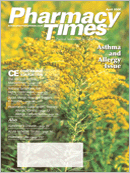Publication
Article
Pharmacy Times
NSAIDs and Antihypertensive Agents
It has been estimated that >50% of theUS population over age 65 has hypertension.Only about one third of allhypertensive patients receiving therapy,however, have reached their goal bloodpressure (BP). Whereas there are a numberof reasons for this poor response toantihypertensive therapy, one that canbe easily controlled is the risk of potentialdrug interactions blunting the effectivenessof antihypertensive drugs. It is thecontrol of BP that reduces the risk ofdeveloping a myocardial infarction, heartfailure, stroke, and renal disease inhypertensive patients. Current hypertensiontreatment guidelines recommendstarting therapy with a thiazide diureticand then adding additional drugs asneeded to control BP. An analysis of >12randomized trials of antihypertensivetherapy found that a 20% to 40% reductionin cardiovascular disease requiredonly a 5- to 6-mm-Hg decrease in diastolicBP.1 This magnitude of BP reductionis typically seen with any single antihypertensivedrug treatment. It is also representsthe usual increase in BP seenwhen nonsteroidal anti-inflammatorydrugs (NSAIDs) interact with antihypertensivedrugs.
Hypertensive patients use NSAIDs for avariety of indications. NSAIDs inhibitprostaglandin-mediated vasodilation andpromote salt and water retention. Both ofthese mechanisms may contribute toNSAIDs partially reversing the effects ofhypotensive drugs, particularly thoseagents whose mechanism depends onmodulating prostaglandins, renin, or sodiumand water balance. The dose andduration of NSAID therapy will partiallydetermine the extent of hypotensivetherapy reversal. Higher doses of NSAIDsand chronic therapy extending beyond aweek will be more likely to increase BP.
Antihypertensive drugs appear to beaffected to variable degrees by NSAIDs.Diuretics, angiotensin-converting enzymeinhibitors (ACEIs), beta-blockers, andangiotensin II receptor blockers (ARBs)are most susceptible to the hypotensivenullifyingeffects of NSAIDs. Calciumchannel blockers and centrally actingantihypertensives seem to be leastaffected. For example, one study foundthat indomethacin reduced the hypotensiveeffect of enalapril by nearly 50%while having almost no effect on nifedipine.2 Similarly, NSAIDs will demonstratediffering abilities to offset hypotensiveresponse to therapy. Indomethacin hasbeen the most widely studied and, alongwith naproxen and piroxicam, appears toproduce the greatest effect. Low-doseaspirin (ie, <250 mg/d) and sulindac havethe least detrimental effect on BP.3,4Elderly patients and those with heart failuremay be more sensitive to the effectsof NSAIDs on their antihypertensive ordiuretic therapy.5-7
Based on the evidence for an interactionbetween NSAIDs and some antihypertensiveagents, the pharmacist shouldbe prepared to offer counseling topatients considering coadministration ofthese classes of drugs. The followingpoints should be considered:
- Although the absolute increase in BPresulting from NSAID coadministrationis usually limited to <10 mm Hg, itcan result in a 50% reduction in theefficacy of an antihypertensive drugand block the beneficial cardiovasculareffects of BP reduction
- Short courses of NSAID therapy (ie,less than a week or 2), even withdaily NSAID administration, areunlikely to cause a clinically importantincrease in a patient's BP
- Short courses of NSAIDs maycause exacerbation of heart failure.Patients should be counseledto report any symptom changesduring NSAID administration.
- Low-dose aspirin therapy does notappear to affect the efficacy ofantihypertensive drugs or diuretics
- Some NSAIDs, such as sulindac,may produce less blunting ofhypotensive efficacy
- Diuretics, ACEIs, ARBs, and betablockersare likely to be moreaffected by NSAIDs than calciumchannel blockers or centrally actingagents. Switching to an antihypertensivedrug not as susceptibleto the blunting effects of NSAIDsshould be considered for patientsrequiring chronic NSAID therapy.
- Consider alternative analgesics,such as acetaminophen, tramadol,or narcotic analgesics, for patientsrequiring analgesics who areunable to have their antihypertensiveregimen altered
- Monitor BP of patients takingNSAIDs for several weeks to determineif they are candidates fordrug regimen adjustments. Also, bealert for signs of fluid retention,such as weight gain or peripheraledema.
By following these simple guidelines,pharmacists can ensure that patientswill receive the maximum benefit fromtheir antihypertensive drug regimen,even if they require NSAID therapy.
Drs. Horn and Hansten are both professorsof pharmacy at the Universityof Washington School of Pharmacy.For an electronic version of this article,including references if any, visitwww.hanstenandhorn.com.
For a list of references, send astamped, self-addressed envelope to:References Department, Attn. A. Stahl,Pharmacy Times, 241 Forsgate Drive,Jamesburg, NJ 08831; or send an e-mailrequest to: astahl@ascendmedia.com.







